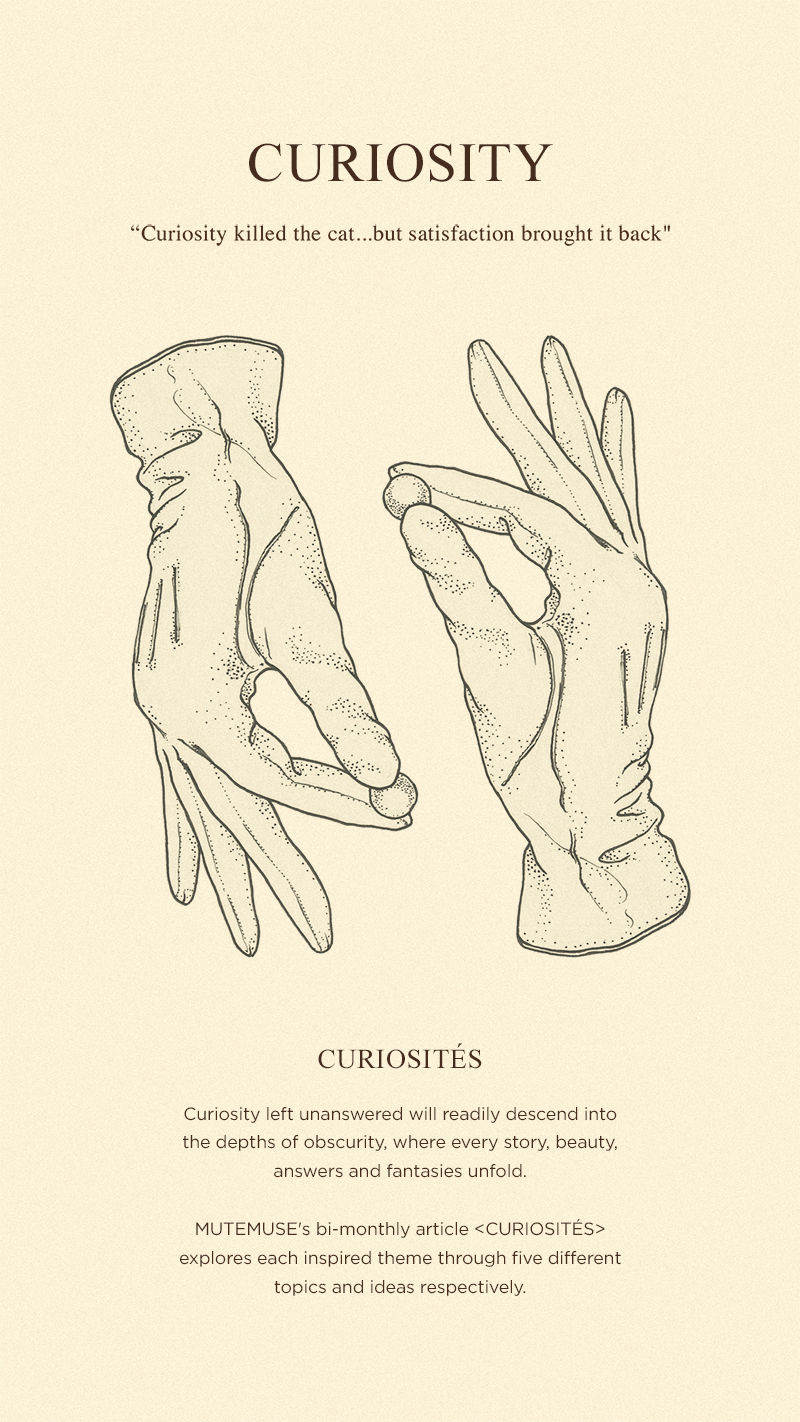Curiosity
CURIOSITÉS


#1 Curiosity
The history of curiosity is the history of everything humanity has desired for; the way we face the most beautiful and the rarest, or the instinct that pushes us through all kinds of adventures and imaginations stronger than any physical force known to mankind.

Kimi&12 <Still Life>, Artwork for MUTEMUSE, 2018
The Evolution of Curiosity
According to the theory of evolution, curiosity is innate in all animals; the more information on survival conditions obtained, the more likely they are to pull through. This is how newborn animals learn by solving their curiosities about unfamiliar environments.
However, human curiosity is a little different; it’s what really makes a human human. It requires effort beyond the very basic instincts to survive or alleviate discomfort. Curiosity had mankind contemplating everything from deadly mushrooms and cavemen’s tools to the private life of a celebrity that we will probably never meet, a symbolic message from last night’s dream, or the attitude of a cat that you’ll never own. Humans are the only animals who just want to know and love to find out.
Curiosity is provoked regardless of compensation; this undeniable drive demands horror movies with drawbacks to every strangely satisfying reveal. They say ‘curiosity killed the cat’, referring to the harm it can cause at times. Yet some humans(and cats) would rather die without being curious. So, curiosity did kill the cat. However, the joy of finding the answer will also resurrect him. Curiosity killed the cat…but satisfaction brought it back!

Baé <Curiosités> Artwork for MUTEMUSE, 2019
Cabinet de Curiosités
Full of Baroque wonders, ‘Cabinet de Curiosités’, or ‘Wunderkammer’ in German, was how European Renaissance nobles showcased their opulence prompted by the heightened curiosity of natural arts and sciences. Starting with small furniture where valuables were kept, the collection expanded to space units and eventually took the form of what we know today as museums. The secret room, through a hidden entrance, holds rare and beautiful objects such as sacred relics, exotic crafts or machinery, small and elaborate artworks, fossils and feathers of mysterious animals, and even the stones of alchemists.
Today, people collect their own ‘Cabinet de Curiosités’ accordingly. Beyond the physical space, curiosity in the 21st century is displayed online as digital archives. Nevertheless, the same rules remain; the one that arouses the most curiosity in others is what holds the highest value in one’s ‘Cabinet de Curiosités’.
Related product: Curiosités Artwork Strap

Lewis Carroll <Alice’s Adventures In Wonderland> Illustrations by John Tenniel, Published in 1865
Curiouser and curiouser
‘Alice in Wonderland’, the epitome of all curiosity-driven tales, is a story of Alice chasing a mysterious rabbit, eating and drinking strange cookies and potions- quite bizarre, to say the least. Opening Chapter 2 ‘The Pool of Tears’, where Alice grows enormously with a bite of a cookie, “Curiouser and curiouser!” defines the story in whole.
`Curiouser and curiouser!' cried Alice (she was so much surprised, that for the moment she quite forgot how to speak good English); `now I'm opening out like the largest telescope that ever was! Good-bye, feet!' (for when she looked down at her feet, they seemed to be almost out of sight, they were getting so far off).

René Magritte, <La Réponse Imprévue> Gouache on paper, 1963-64
The Unexpected Answer
Obviously, someone—or something—went through this door; the unidentifiable silhouette chose to disregard the convenience to open the door or to turn the light on.
Magritte was a mischievous artist who gave new meaning to things and enjoyed the paradox he had created. Just look at how he drew this room with the door closed but open, hidden yet exposed, and decided to call it ‘a room more curious than a closed one’. Yes, the essence of all thrillers emanates from questioning the unknown darkness. With that, the fundamentals of curiosity always follow—”Who, when and where? What, how and why?’
If so, maybe the silhouette of this hole is the curiosity that consumed us all into this painting. Thus, no matter what kind of assumptions we make, it’s always La Réponse Imprévue, or The Unexpected Answer, that walks out this door.

Georges Méliès <Le Voyage dans la Lune> Released in 1902
Space Expedition
Astronomy is the oldest study of science in human history, and the stars one of the oldest mythological motifs. Humans knew how to read the sky before they knew how to build a house and sang of stars before they began to speak. Since anyone can remember, the uncertainties of the universe have been the striking matter for us. The first SFX science fiction film, Georges Méliès’ A Trip to the Moon(Le Voyage Dans La Lune)(1902), proves what mankind has been envisioning all along.
On August 18th, SpaceX successfully launched its record-breaking sixth liftoff of the Falcon 9. NASA has spent over $900 billion in space exploration so far. The first space tourist was willing to pay about $20 million, and Blue Origin’s 11-minute space tour ticket, which is expected to cost at least $300,000, has more than 800 people on the waiting list. Why spend an absurd amount of time and money on a fleeting moment to the furthest place possible? For the advancement of science? To boast the once in a lifetime experience? All this is merely subsidiary. The real reason lies behind the inexplicable trait, the curiosity that has been tempting us from the very beginning.
Directed by MICHELLE PARK, NOELLE YANG
Written by NOELLE YANG
Eng Translation by MICHELLE PARK
Designed by JUNSEON YU
Cover Illustration by BAÉ
Produced by STUDIO PARENTHÈSE
Review
There are no posts to show
Q&A
There are no posts to show











